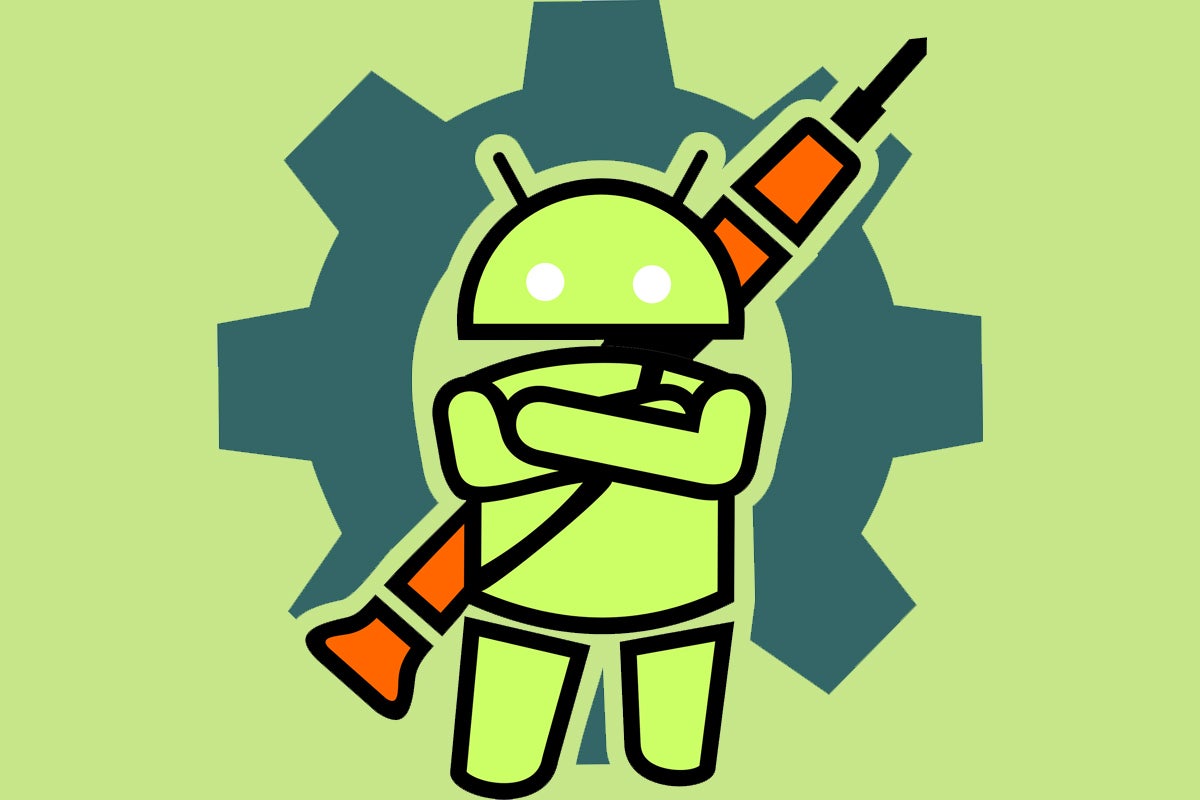Confession time: I know embarrassingly little about car repair, and I couldn't fix a misbehaving house appliance if my life depended on it (which, on at least a couple occasions, it almost has). Heck, I can barely hang a piece of wall art without screwing something up along the way. When it comes to Android phones, though, well — I'm practically a modern-day mechanic.
Now, hang on a sec: It isn't nearly as impressive as it sounds. I don't have any fancy power tools or even a pair of cool-looking coveralls with my name on 'em (not yet, anyway). I've mostly just been using and studying Android for a long time now — since somewhere in the mid-1800s, give or take — and when you pay close enough attention to something for a long enough period, you start to see the same basic patterns popping up time and time again.
The truth is that for as "magical" as they may occasionally appear, our sleek and shiny smartphones are ultimately just appliances. And more often than not, the issues most folks have with their phones are pretty darn consistent. That means whether you're troubleshooting your own device or trying to come to a struggling co-worker's rescue, the odds are good that your problem can be addressed without too much trouble.
Consider this your guide — a collection of some of the most common complaints I hear about Android phones and the simplest solutions I suggest in those scenarios. Apply the knowledge to your own ailing device or pass it on to someone else who needs it, and you, too, can experience the joy of feeling like a mobile-tech mechanic (with or without the coveralls).
Android problem No. 1: Low storage
Ah, yes — the age-old problem of finite space. When you see a phone's storage starting to run low, just remember this catchy little adage: "Stop hoarding stuff, you unruly digital packrat." (Okay, so maybe it wasn't quite as catchy as I had hoped.)
In all seriousness, though, most of us really don't need much stored locally on our smartphones these days — especially on Android, where cloud syncing is simple and automated management is easy. Start by installing the Google Photos app and setting it up to back up all photos and videos as they're taken. That'll let you delete the local copies (as well as have a great way to get to all your memories from any device, anytime, even if you lose or break your current Android phone), and that alone is bound to free up tons of room.
Second, install the Files by Google app. It'll show you all the unnecessary space-takers lurking within your phone's storage — including those now-redundant local copies of cloud-synced images along with junk files, duplicate files, and other easily eliminated things — and it'll give you simple one-tap buttons to clear any of that crud away.
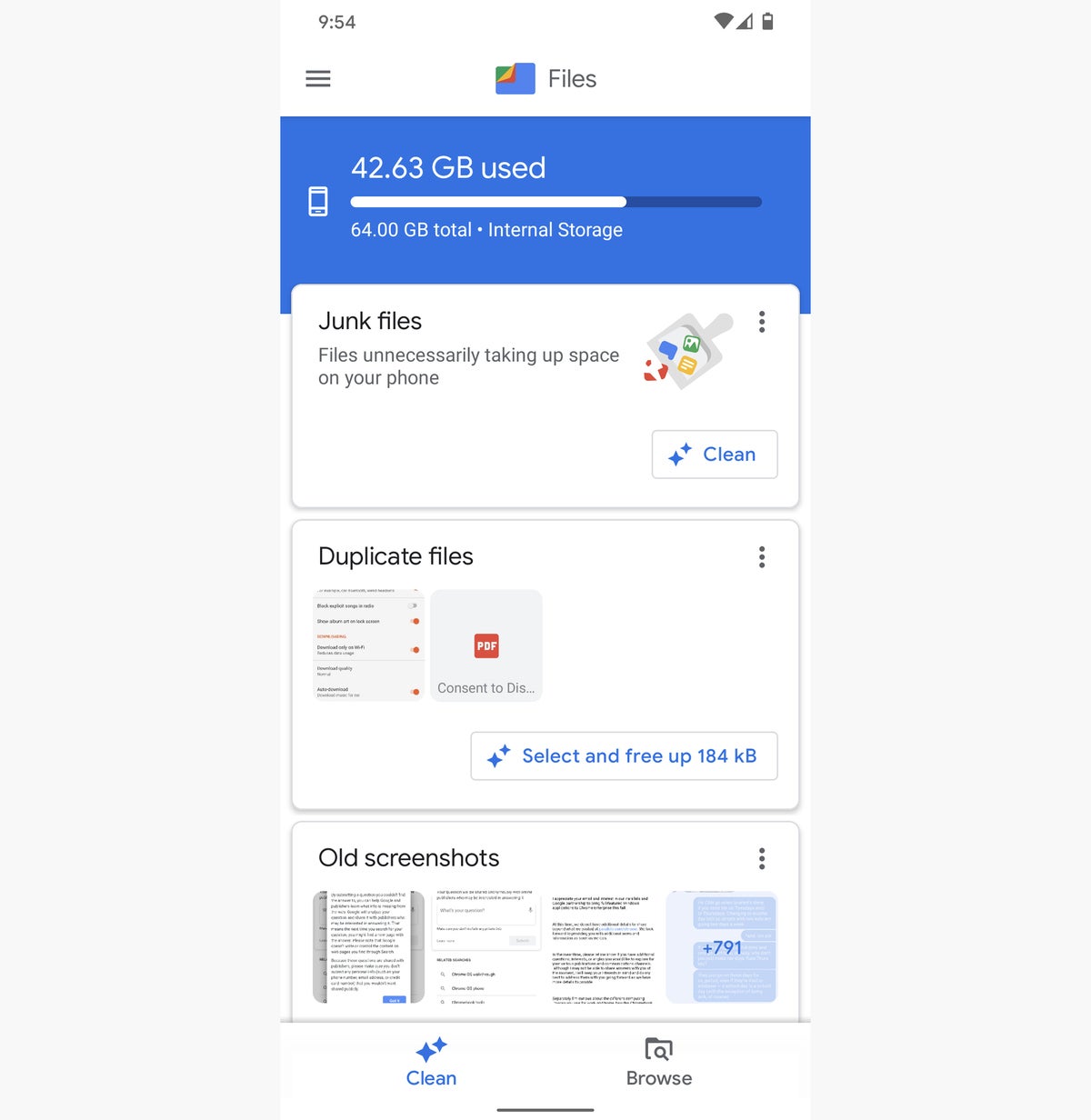 JR Raphael/IDG
JR Raphael/IDG
The Files by Google app identifies areas where you can free up space and gives you a quick 'n' easy way to zap unneeded items away.
Finally, if you're using one of Google's Pixel phones, look in the Storage section of your system settings and tap the line labeled "Smart Storage." There, you can configure your phone to automatically remove any redundant copies of already-backed-up photos and videos anytime your storage starts to get low again.
Android problem No. 2: Subpar stamina
We could talk about Android battery life all day, but the fastest way to make an immediate difference in your phone's longevity is to adjust your screen settings.
First, turn down the screen's brightness (either in the Quick Settings panel that comes up when you swipe down twice from the top of your screen or in the Display section of your system settings). The display burns through more power than anything else on your device, and the lower you can comfortably use it, the longer your phone will last with each charge. If your phone is running Android 9 or higher, you can also look for an Adaptive Brightness option that'll automatically adjust the brightness level for you based on your current environment.
Second, set your "Screen timeout" setting (also in the Display section of your system settings) to as low of a value as you can tolerate. The less time your screen stays on when you aren't using it, the less unnecessary battery power your phone will burn through.
And third, if you've got Android 10 or higher, look in that same area of your system settings for the Dark Theme option. Darker colors tend to consume less power than the bright hues present in most interfaces by default, so switching to the Dark Theme either all the time or even just on a sunset-to-sunrise schedule should extend your phone's battery a fair bit.
Android problem No. 3: Too much bloatware
Unless you're using Google's Pixel phones, your Android device likely came loaded with lots of junk you don't want — ranging from superfluous manufacturer-provided services (hi, Samsung!) to carrier-added crapola (to use the highly technical term). But fear not, for most of that can at the very least be hidden out of sight, if not eliminated entirely.
The simplest way to do that is to look in the Apps section of your system settings to find the complete list of installed applications. When you see an app that you don't want, tap its name and then look for either the Uninstall button — or, if that isn't present, the Disable command. You may not be able to get rid of absolutely everything that way (paging Bixby...), but you'll be able to clear out a fair amount of clutter.
Android problem No. 4: A home screen mess
From built-in search bars you don't use to silly news streams you'd rather not see, Android phones' home screens are often anything but optimal out of the box. But you don't have to live with what your device-maker gives you. Android has a huge array of third-party launchers — alternate environments that completely replace your phone's stock home screen setup and app drawer arrangement. And there's something available for practically every preference and style of working.
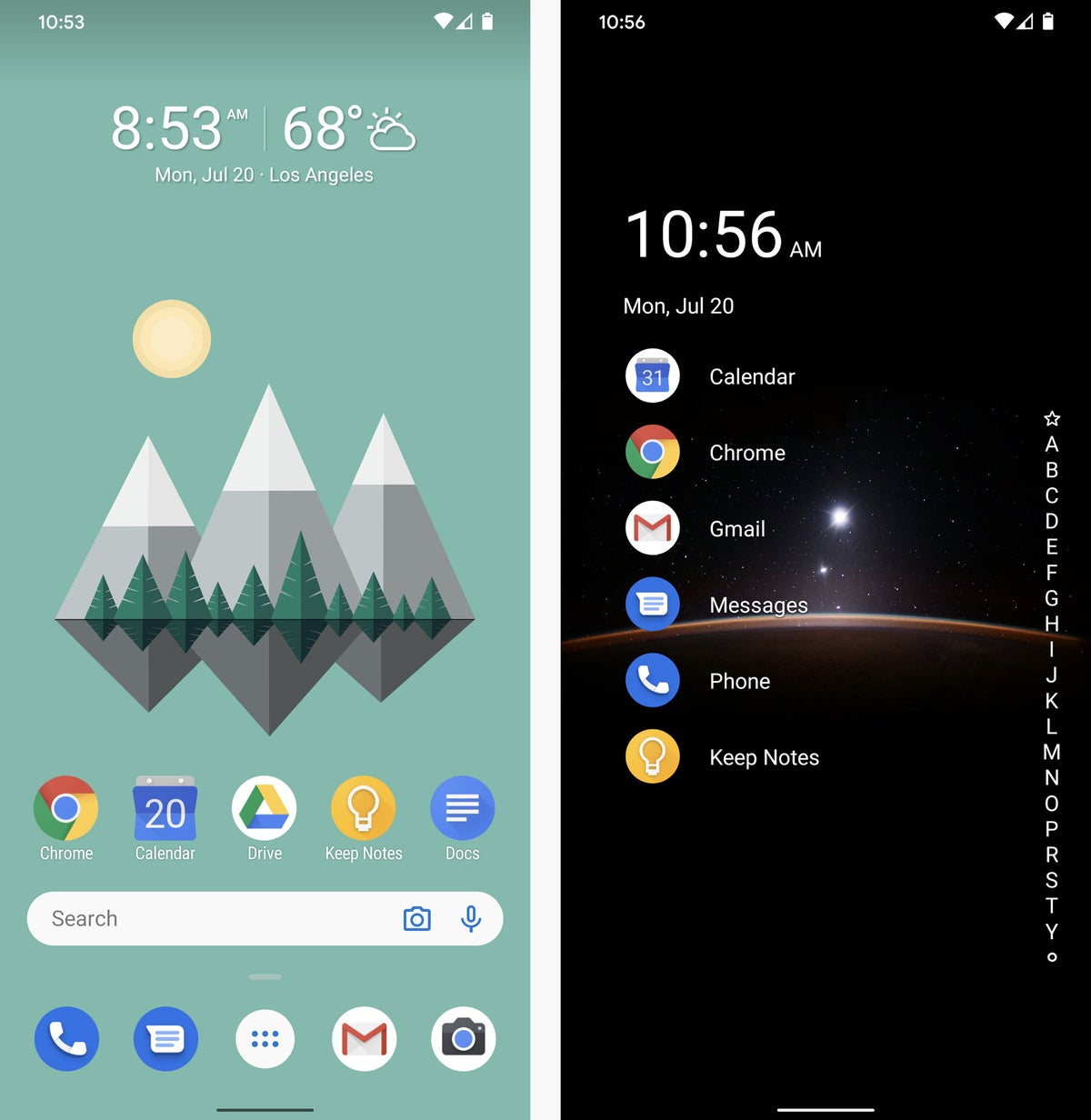 JR Raphael/IDG
JR Raphael/IDG
Third-party launchers such as the Microsoft Launcher and Niagara Launcher, seen here, can clean up your home screen and make it custom-suited to your work style.
Look through my Android launcher recommendations to find what's right for you — then check out these Android productivity tips for making the most of your spiffy new setup.
Android problem No. 5: A slow-running phone
Just like us mortals, smartphones are prone to slowing down over time as their virtual wits become worn. Unlike our mushy mammal brains, though, your phone's response time can actually be improved.
Some of the things we just went over, in fact, should make a noticeable difference: cleaning up your storage, uninstalling unused apps (both ones that came pre-installed on your phone and ones you installed yourself but no longer use), and trying out a custom launcher for a more optimal home screen environment.
Beyond that, some of the same steps I describe in my Android data-saving guide can bring a meaningful boost to your overall device speed — things like eliminating unnecessary background activity, compressing your mobile web experience, and shifting to lightweight versions of apps. (See that article for a step-by-step breakdown in each of those areas.)
And finally, a tucked-away Android system setting may make the most perceptible impact of all. You'll first have to activate Android's developer settings on your phone to find it:
- Open the About Phone section of your system settings and look for the line labeled "Build number." (On Samsung phones, you'll have to tap a line labeled "Software information" before you'll see the "Build number" line.)
- Tap that line seven times.
- Enter your PIN, pattern, or password when prompted.
Once that's finished, go back to your main system settings menu. On some phones, you'll see a new Developer Options section right in that main menu; on others, such as Google's Pixel devices, you'll have to enter the System section and then tap "Advanced" to find it. However you get to it, tap that section and then scroll down until you see the Drawing header.
There, you'll find three animation-related options: "Window animation scale," "Transition animation scale," and "Animator duration scale." Tap each of those items and change its setting from the default "Animation scale 1x" to "Animation off." And don't mess with anything else in that Developer Options area while you're there; it contains some complex stuff that isn't meant for regular phone owners and could mess up your phone if used incorrectly.
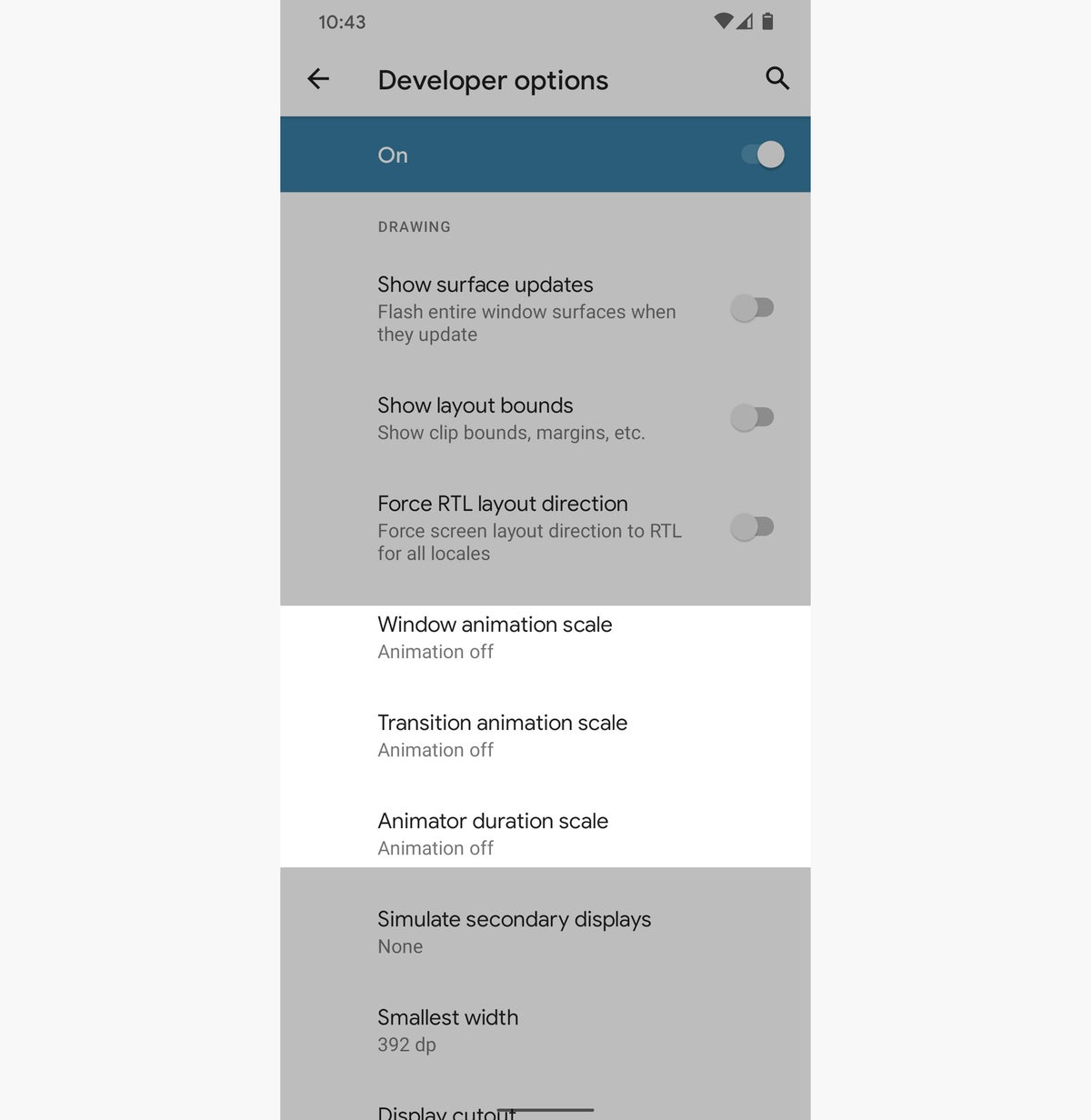 JR Raphael/IDG
JR Raphael/IDG
Android's animation scale settings, hidden away in the system's Developer Options, can make any phone feel instantly faster.
Head back to your home screen and try moving around your phone — opening your app drawer, swiping down the notification panel, going in and out of apps, and so on. Everything should feel significantly snappier than it did before.
Android problem No. 6: Too much rotation
Our phones are designed to work in both a portrait and a landscape orientation — but sometimes, the sensors get a little oversensitive and end up flipping between views more often than you'd want.
As of Android 9, there's an easy answer: On a Pixel phone or any device whose manufacturer hasn't meddled with Android too much, march into the Display section of your system settings, tap "Advanced," and then flip the toggle next to "Auto-rotate screen" into the off position. From there on out, anytime you rotate your device, it won't automatically change the screen's orientation and will instead place a small icon in the corner of the screen. You can then tap that icon to change the rotation or ignore it to leave it as-is.
If you're using a Samsung phone, the feature curiously isn't in your system settings, but you can find a toggle for it in the Quick Settings area that comes up when you swipe down twice from the top of your phone. Look for the icon labeled "Auto rotate" and tap it once to disable it (which will change its title to "Portrait," somewhat confusingly — but that'll do the trick).
Android problem No. 7: Tiny text
Stop squinting, would ya? If the words on your phone are too damn small, head into the Accessibility section of your system settings and try out two options: "Font size," which will increase text all throughout your phone, and "Display size," which will increase the size of everything on your screen.
Android problem No. 8: Annoying notifications
Whether it's an overly aggressive app or, ahem, an overly aggressive texter, stop notification nuisances at their source by pressing and holding your finger to the next unwanted alert that pops up. That'll pull up a control panel of sorts that lets you turn off the associated type of notification entirely — or just silence it so that it still shows up but doesn't actively demand your attention.
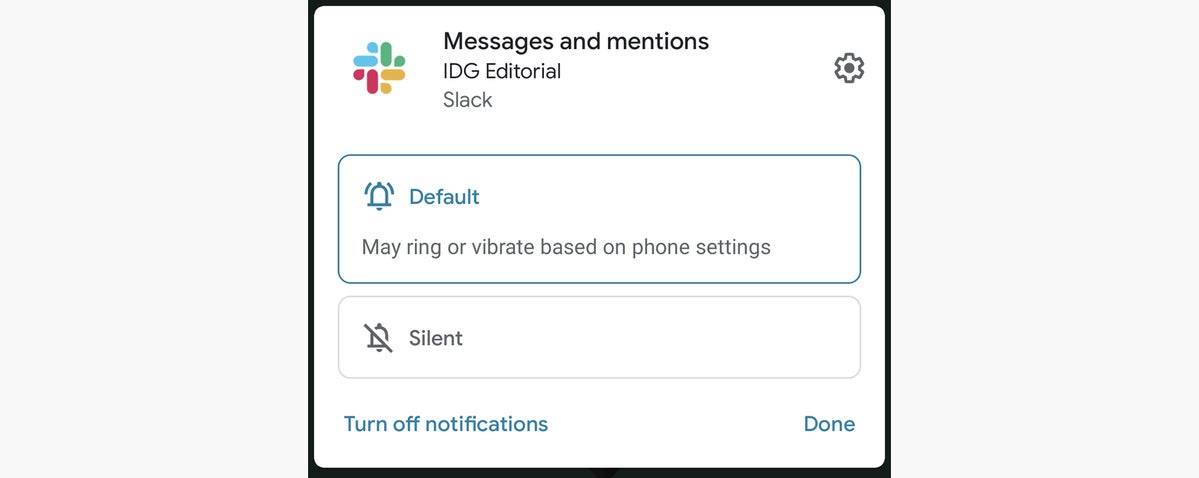 JR Raphael/IDG
JR Raphael/IDG
Less annoying notifications are always just a long-press and a tap away.
Android problem No. 9: The contacts conundrum
It's 2020, for cryin' out loud. Your contacts shouldn't be accessible only on your phone — and you shouldn't have to jump through hoops to "transfer" them from one device to another.
If you're using a phone made by anyone other than Google, go into its Contacts app and make sure it's set to sync your info with your Google account — not with the manufacturer's own proprietary syncing service. This is especially pertinent for Samsung owners, as the company tends to sync contacts with its own self-contained service by default. That's fine if you only want to access that info from that one phone and if you only plan to purchase phones made by Samsung in the future, but in any other scenario, that setup is not going to serve you well.
In Samsung's Contacts app, tap the three-line menu icon in the upper-left corner, then tap "Manage contacts" followed by "Default storage location." Then, select your Google account instead of your Samsung account in the menu that comes up.
From that point forward, your contacts will be synced with Google Contacts — which means they'll always be available within the Google Contacts website, from any computer where you're signed in, and they'll be immediately available on any phone where you install the Google Contacts Android app.
Android problem No. 10: Call-ending challenges
Ever find yourself scrambling to end a call — but then your screen won't come back on fast enough? Or maybe the screen comes on, but the command to hang up isn't right there and ready? An Android accessibility option can make your life infinitely easier by empowering you to press your phone's physical power button anytime you're ready to say goodbye. No need to hunt around for the right icon or even look down at your phone at all — just one button press along the device's edge, and the person on the other end will be gone (thank goodness!).
Just look for the "Power button ends call" option in that Accessibility section of your system settings, flip it on, and get ready to get off a call more easily than ever.
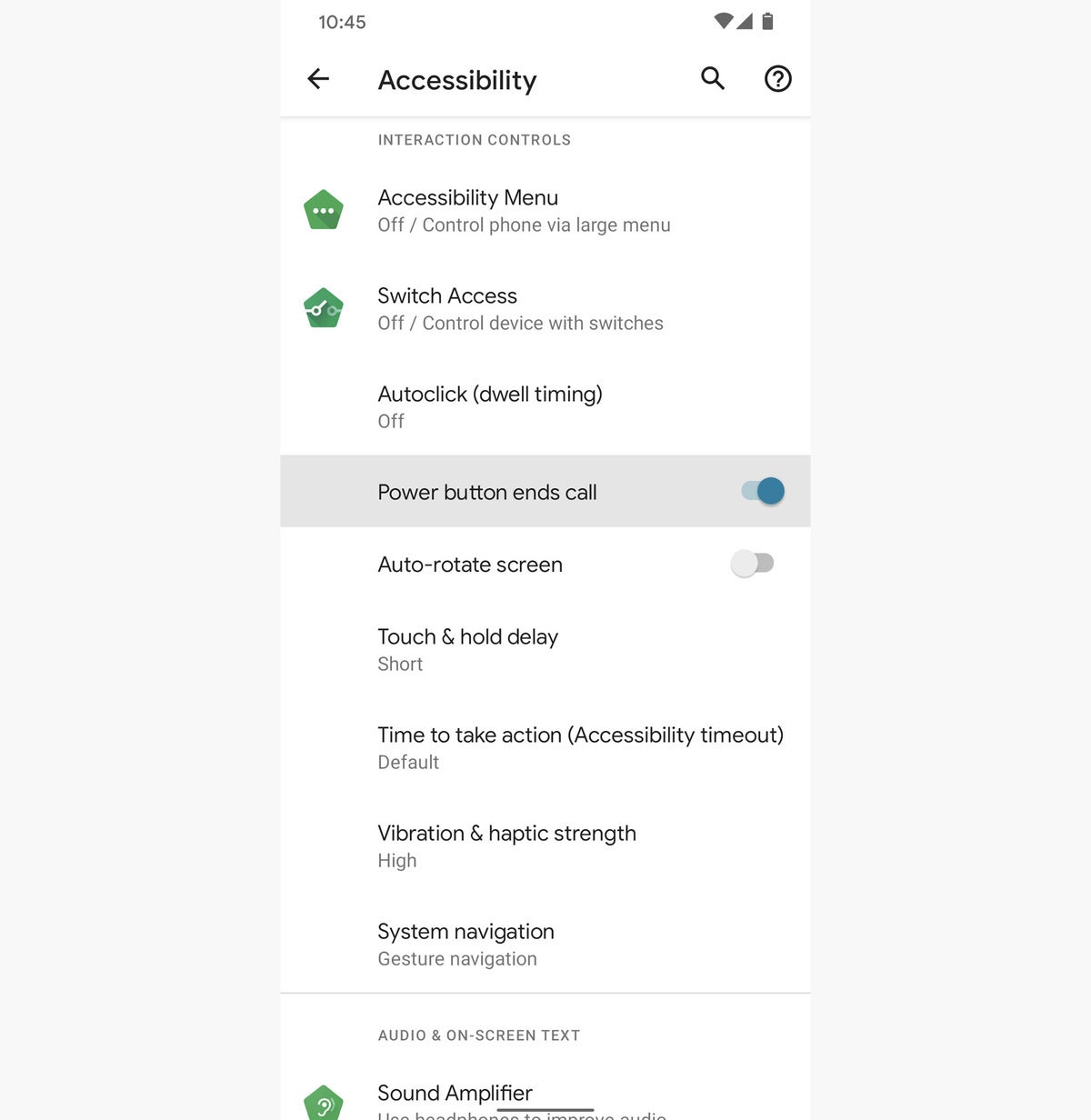 JR Raphael/IDG
JR Raphael/IDG
If you dig around enough in Android's settings, you can find a switch that'll make it much easier to end a call.
Android problem No. 11: A frozen phone
One of the most frustrating Android problems of all is having a phone that's either stuck on some process and not responding or stuck in a powered-off state and refusing to turn on. But no matter how dire things may seem, there's almost certainly always a solution.
The simplest one is a hard reboot: Depending on your device, you'll want to press and hold either the power button by itself for 30 seconds to a minute — or press and hold the power button and volume-down button together for that same amount of time (or until you feel a vibration and see something show up on the screen). If you see a strange-looking menu that says "Start" and has a picture of an Android robot, don't worry: Just press the power button again, and your phone should boot up normally.
If nothing happens with either of those processes, try leaving your phone plugged in for a solid few hours, just to make sure the battery isn't depleted. Then try again.
If things still aren't coming up — and if you aren't seeing even the standard battery indicator graphic appear on the display when you plug the phone in — well, my friend, it's time to make your way to our final Android issue.
Android problem No. 12: A non-charging phone
Last but not least is the problem to end all Android problems: an Android phone that simply won't charge (and thus also won't power up, once its battery has been run all the way down). I've been there. And while it's certainly possible that you could be facing some sort of hardware-related defect, it's also quite likely that this is something you can fix in a jiff.
So try this: Take something like a toothpick or the end of a paper clip and very carefully and very gently dig around a little in the phone's charging port to clear out any lint or debris that's built up in there. It sounds crazy, I know, but sometimes, enough gunk gets collected in that area that the power cable isn't able to establish a good connection and charge the device (or charge it consistently, without the connection coming in and out and making it difficult for much charging to happen).
Once you've cleared out a good amount of gunk, plug the phone in again and see if something happens. If the battery was totally dead, you might have to leave it plugged in for a while before you see any results. But there's a decent chance this will work — and then, in a matter of minutes, you'll be back in business.
Sometimes, the simplest fix is the most satisfying one of all.






